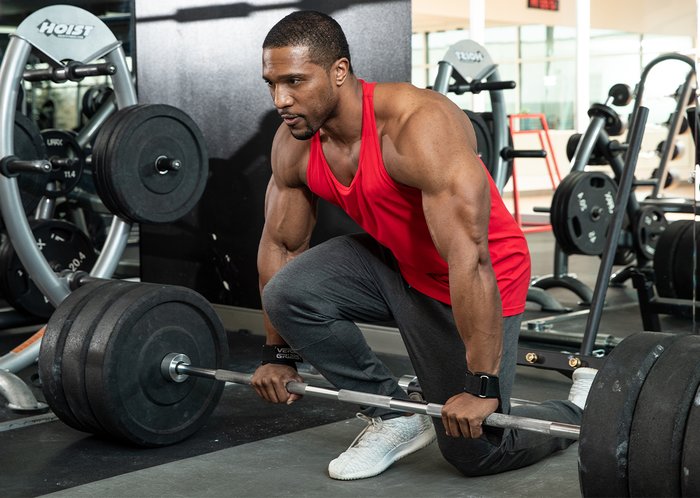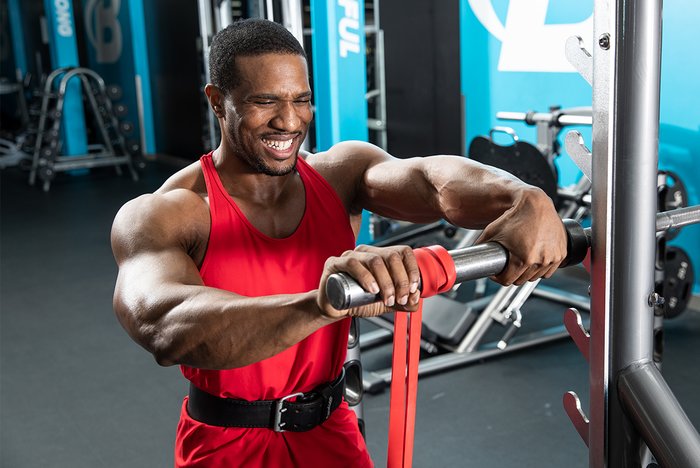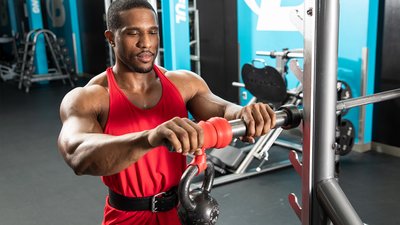Wrist rollers were a gym staple in the 1990s and early 2000s, and if you were ever a young athlete with hours to burn hanging out in the weight room during those years, chances are that you played around with one at least once. For most people, once was enough. The first time you do it, the wrist roller is a truly torturous exercise, drowning you in a burning feeling after just a few minutes.
I remember doing burnout sets in high school for my end-of-workout grip-strength training. You know what I never understood, though? The most intense burn was always in my shoulders, not my forearms.
The problem, it turns out, wasn't with my technique, it was with the tool I was using. In this article, I'm going to show you why everything you know about the wrist roller is wrong. With just a little ingenuity, you can integrate a better version of the wrist roller into your workouts to help build bigger, stronger forearms in a hurry.
All you need to start is a barbell, a rack, and a cord or band.
First, Throw Your Old Wrist Roller in the Trash
You know the one I'm talking about. It's got skinny neoprene-covered handles and a shiny center hub to which a thin rope and a few 5-pound plates attach. You hold it up for 2-3 minutes until your front deltoids scream, then give out. You continue pulling 5-10 pounds up and down over and over until the lactic acid burn is so intense, that your shoulders feel like they're about to explode.
Here's the thing: if you want bigger deltoids, great! Go grab some dumbbells, stare at yourself in the mirror by the dumbbell rack and go nuts. There are a million good dumbbell exercises for shoulder development—the wrist roller shouldn't be considered one of them.
But if you want to develop your forearms, improve your grip, and help your elbows feel better, then we're onto something.
What Was That About My Elbows?
That's right. You may want bigger forearms and a stronger grip, but most people don't realize how much they also need the wrist roller in their arsenal. There's one major reason why: The average lifter almost never gets forearm extensor work.
Plenty of people are training their forearms and hands to be strong, to squeeze and crush and hold massive weights, and just to look like they lift. It's a cultural shift that really is terrific. Grip strength has always been a foundation of the training programs I create for young athletes in my facility, but I always felt that grip training was underutilized by the common lifter. It's valuable for everyone since we work with our hands in nearly everything we do.

But I've also seen firsthand (so to speak) how most people neglect a big part of forearm training. The anterior compartment of the forearms—the muscles responsible for making a fist, curling a weight, and holding a heavy barbell—is just one aspect of the forearms functionality. Anyone who does frequent heavy rowing exercises, farmer's carries, and deadlifts will tell you that their elbows get cranky when they do too much. That's often because their flexors are overdeveloped, and their forearm extensors are underdeveloped.
The extensors get no love, and that's partly because there aren't many exercises that target them well. To make matters worse, the exercises that do target the extensors feel more like rehab than training.
We need something better. Enter the barbell wrist roller.
A New Way to Use the Same-Old Bar
When I introduced barbell wrist roller about five years back to the athletes I train, they quickly became a favorite grip exercise. Why? Because it's fun and challenging, but it's also a grip exercise that anyone can do—and one that everyone, without exception, really feels in the forearms.
There's something special about this burn. Bodybuilders, competitive athletes, and just general fitness enthusiasts need to feel it every once in a while. It lets them know that they're working hard and forcing muscle groups to grow.
With barbell wrist rollers, you'll be certain which muscle group you're working, and it will not be the shoulders. As a bonus, it's one of the few grip exercises that is dual duty, allowing you to absolutely demolish both the forearm flexors and extensors. It's a massive win for building bigger forearms and keeping your elbows happy.
I have two methods for setting up barbell wrist rollers in your local gym, so no matter who you are or where you train, you can integrate these immediately into your workout regimen.
First: The Center Barbell Method
Barbells have rotating end sleeves, so we can use these to our advantage in a couple of ways:
- Use the center of the barbell as a skinny wrist roller in a power rack.
- Use one of the end sleeves as a fat wrist roller.
If you're someone who is already using thick grips in your training like I recommend in my article "The Do's and Don'ts of Fat Grip Training," you could also put Fat Gripz on the center of the barbell to give it some heft.
Watch the video below to learn how to make one using the center portion of a barbell.
Second: The End-Sleeve Fat Wrist Roller Method
You can also use the end sleeves as a fat wrist roller, with no rubber grips required. Watch the video below to see how you do it.
Step 1: Choose one end sleeve of a barbell to use and counterweight the other.
Put a barbell in the rack at about chest height or slightly lower. Then, add weight to one side of it as a counterbalance. You can use more weight than you think on the barbell wrist roller, so don't risk having a catastrophic incident where the barbell tips over and comes flying toward your face.
Most lifters will use somewhere between 25-80 pounds on the roller, so a 45-pound counterweight will typically work fine. Always be safe and test the balance of the bar before you get going, and if it seems at all unstable, pick a matching counterweight to the weight you're using.
Step 2: Girth-hitch a looped power band over the end of a kettlebell, dumbbell, or weight plate.
In my experience, 25-pound plates work best for this, but kettlebells work fine, as well. Girth-hitching is when you pull one end of a loop inside and through the other. You've probably done it before but likely didn't know the name. The looped nylon webbing used by climbers is also a very durable, non-stretching alternative.
Step 3: Wrap the other end of the band twice around the barbell sleeve.
Double it over so that it binds on itself and wraps up the bar as you turn it. Once over won't quite cut it, because the band will just spin around rather than actually raising the weight.
The band and weight now have enough friction to cause the barbell to roll the band up as you turn it. Your wrist roller is complete.
How to Use the Rack Wrist Roller
Regardless of which setup you choose, you will need a plan to get the most out of it. Here are my favorite ways to use rack wrist rollers. Check out the video below for a brief explanation of each exercise and exercise type.
One Hand at a Time
Turn the roller as far as possible with one hand, then grab it and turn as far as possible with the other. This will make it much tougher on each individual arm in addition to providing the maximum range of motion. Do it both with a focus on flexion (turning the bar away from you) and extension (turning the bar toward you). Alternating sets of both variations is a no-brainer.
Two Hands at a Time
This variation is a little more complicated but allows you to move more weight. Just turn the bar toward or away from you with both hands, then hold it with one while you get the other hand back into position. It also works with both flexion and extension.
Eccentric and Concentric
Wind the roller all the way up, and then unwind it slowly with your hands controlling the pace. This will both give you a pump and do muscle damage to help you add some beef to your forearms.
Concentric Only
Wind the roller all the way up, and then let the weight spool back down to the ground with gravity. By only raising the weight and not lowering it, we eliminate the eccentric component (the lower phase in an exercise) which can reduce soreness. This is especially valuable for an athlete who is in-season and doesn't want to be sore for an upcoming game.
Go Fast for a Serious Pump
Everyone knows that progressive overload—increasing resistance and workload over time—is key to building muscle strength and size. But bodybuilders also use metabolic stress (i.e., "the burn") to force stubborn muscle groups to grow.

By pumping a muscle full of blood and nutrients, it's bathed in everything it needs to grow bigger and stronger. The wrist roller, when done very fast with no breaks between wind-ups, elicits a massive forearm pump that is hard to find elsewhere.
If you're looking for sets and reps to guide you, sorry. It'll be different for everyone. But a good place to start is by putting 20-25 pounds on the band and keep going until you can't go anymore. If the pump doesn't show up pretty fast, add weight.
Go Heavy!
Because your shoulders are no longer the weak link, the days of using 5-10 pounds on wrist rollers are dead. Pack the weight on the bar and see how much you can get up! Fifty pounds and up is challenging for an average weight-training enthusiast. If you can roll up 100 pounds, you're on your way to a world-class grip.
Don't be shy. Go heavy and see what you've got.
Bigger Forearms Are Just a Power Rack Away
Once you try the wrist roller, you'll never go back. It's fun, challenging, and extremely effective. For those who want healthier elbows, the extensor training wrist rollers can provide is invaluable. And for those who just want bigger, stronger forearms, the heavy resistance and incredible muscle pump can be just the ticket.
Give these a try in your next workout and let me know in the comments how it worked for you, if you can still type!
Looking to improve more than just your grip strength? Check out Jim Stoppani's 6-Week Shortcut to Strength on Bodybuilding.com BodyFit Elite.

